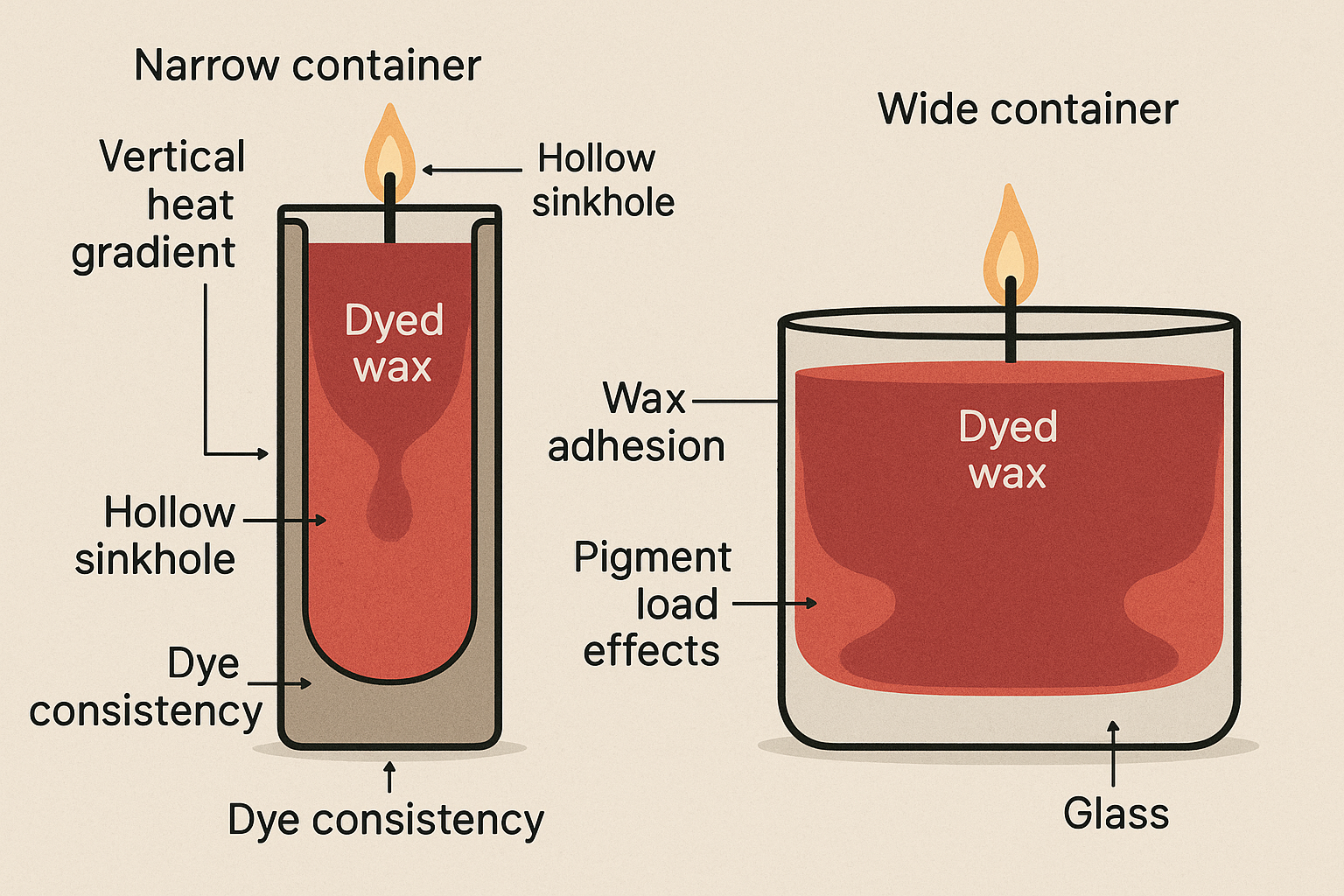A sinkhole is a structural failure in the wax body. It results from improper cooling dynamics, often influenced by wax type, temperature, and mold preparation. Solving this issue involves refining pouring techniques and choosing wax blends with optimal cooling profiles.
There are two main types of candle systems: single-pour systems and dual-pour systems. Dual-pour methods allow artisans to top off cooling gaps after the initial contraction phase. The primary benefit of mastering sinkhole repair is improved surface uniformity, leading to higher product quality and reduced candle waste.
What Causes Sinkholes in Candles?
Sinkholes form in candles when the wax contracts unevenly during cooling, creating hollow pockets in the center. These cavities arise when the outer wax sets faster than the interior, pulling away from the wick and sides. As the wax cools, its volume decreases, and without sufficient internal support or escape paths for trapped air, a depression forms beneath the surface.
The cooling pattern depends on wax mass, container surface area, and room conditions. Deeper vessels tend to harden from the outside inward, trapping soft wax inside. As wax solidifies, air trapped in the middle creates a gap — a sinkhole — unless a second pour or airflow escape is provided.
Poor adhesion to the wick and container walls contributes to irregular cooling. Wicks misaligned from the center increase the chance of uneven temperature gradients, especially in large-diameter molds.
Understanding how wax contracts under thermal gradients lays the foundation for analyzing how specific wax types and additives influence sinkhole risk.
How Wax Density and Additives Affect Sinkhole Risk
Wax density and additive compatibility significantly affect the likelihood of sinkholes by altering the wax’s cooling rate and structural cohesion. Dense waxes like paraffin retain heat longer, cooling unevenly and increasing the chance of trapped air. Soy wax, though softer, can still contract sharply unless additives are balanced.
Fragrance oils influence viscosity. Thick oils, especially those incompatible with the wax blend, can destabilize solidification and introduce air pockets. Additives like stearic acid increase hardness and reduce shrinkage by slowing the contraction process.
Certain blends, such as paraffin–soy hybrids, reduce sinkhole formation due to balanced thermal behavior. Testing pour temperatures and fragrance load limits helps match wax chemistry to mold size and ambient conditions.
Because wax chemistry isn’t the only factor, it’s important to consider how room conditions like temperature and humidity contribute to surface stability during the cooling phase.
How Wax Density and Additives Affect Sinkhole Risk
Wax density and additive compatibility significantly affect the likelihood of sinkholes by altering the wax’s cooling rate and structural cohesion. Dense waxes like paraffin retain heat longer, cooling unevenly and increasing the chance of trapped air. Soy wax, though softer, can still contract sharply unless additives are balanced.
Fragrance oils influence viscosity. Thick oils, especially those incompatible with the wax blend, can destabilize solidification and introduce air pockets. Additives like stearic acid increase hardness and reduce shrinkage by slowing the contraction process.
Certain blends, such as paraffin–soy hybrids, reduce sinkhole formation due to balanced thermal behavior. Testing pour temperatures and fragrance load limits helps match wax chemistry to mold size and ambient conditions.

Cross-sectional visual of paraffin–soy wax blend showing how density and additives affect sinkhole risk
Beyond environmental influences, the physical design of containers and the consistency of dyes also impact how evenly wax cools and adheres during solidification.
Can Room Conditions Cause Candle Sinkholes?
Ambient temperature, humidity, and altitude affect how wax cools and whether it forms sinkholes. These environmental conditions alter surface tension, heat dissipation, and air pressure inside the mold during solidification. When poured into a cold room or exposed to drafts, wax cools too quickly on the surface, trapping soft wax and air beneath.
High-altitude environments are especially prone to uneven cooling because of lower air pressure. Wax expands and contracts differently, requiring longer cooling times and adjusted pour temperatures to avoid structural failure.
Humidity also plays a role, especially with soy or blended waxes. High moisture levels interfere with wax–container adhesion, causing uneven surface formation.
Pre-warming containers and maintaining stable room temperature between 21–25°C helps prevent sudden thermal shifts that lead to hollow centers.
Preventing these structural issues begins before pouring, through controlled preparation and technique-driven adjustments to temperature and timing.
Do Container Shape and Dye Type Matter?
Container shape and dye thickness influence wax contraction patterns, with each configuration posing unique risks.
🧱 Container Shape Comparison
| Attribute | Narrow/Deep Container | Wide/Shallow Container |
|---|---|---|
| Cooling Pattern | Hardens top-down and outer-in | More uniform across surface |
| Sinkhole Likelihood | High — air trapped beneath center | Lower — fewer central voids |
| Material Risk Factor | Glass/ceramic retain heat; uneven solid | Metal cools fast; surface sets quickly |
🎨 Dye Type Comparison
| Attribute | Thick/Heavy Pigment | Thin/Low-Viscosity Dye |
|---|---|---|
| Wax Adhesion | Interferes with wick base and wall grip | Promotes full mold contact |
| Cooling Impact | Delays setting, raises air pocket risk | Enables even shrinkage and solidification |
Best practice: Use wide containers with low-viscosity dyes to reduce sinkhole probability.

Cross-section comparing narrow and wide candle containers showing how geometry and dye affect sinkhole formation
Even with careful prevention, some sinkholes still form — making it essential to know effective post-pour repair methods that restore surface integrity.
Fix Sinkholes After Candle Pouring
Sinkholes that appear after cooling can be repaired using controlled reheating or additional pouring. These post-processing methods smooth the surface and restore wax uniformity without compromising wick function or burn quality.
Step 1: Inspect the Surface for Soft Spots
Press gently at the center once the wax has cooled for 2–3 hours. If the surface gives or sinks, the cavity extends beneath and requires repair.
Step 2: Use a Heat Gun to Re-Melt the Top Layer
Hold a heat gun 10–15 cm above the candle and warm the surface until it liquefies evenly. Use a sanitized skewer to release any trapped air before letting the wax settle naturally.
Step 3: Perform a Second Pour
Heat leftover wax to 3–5°C lower than the original pour temperature. Fill only the cavity area without disturbing the wick. Let it cool in a stable environment to avoid layering bubbles.
Step 4: Use a Hairdryer or Oven if Needed
In the absence of a heat gun, a hairdryer on low or an oven set at 65°C can soften the surface. Never exceed 10 minutes to prevent melting the wick mount.
Some waxes are more prone to forming sinkholes than others, requiring different approaches depending on their cooling profiles and physical properties.
Which Wax Types Are Most Prone to Sinkholes?
Votive, soy, and paraffin waxes are most susceptible to sinkholes due to their high shrinkage rates and slow interior cooling. These wax types contract significantly during the solidification phase, creating air pockets and hollow centers if not managed with second pours or proper additives.
Votive wax, used in molded forms, contracts aggressively and traps air unless repoured after the initial cooling. Soy wax has a soft structure but shrinks unevenly, especially in deep containers. It often benefits from stearic acid or beeswax blending to stabilize the finish. Paraffin wax cools from the outer edges inward and retains heat longer, which can create sunken tops if surface tension breaks early.
Beeswax and coconut wax generally resist sinkholes better due to their lower shrink rates and tighter grain structure. Still, they can crack if poured too hot or cooled too fast.
Choosing the right wax type based on mold depth, fragrance load, and dye level can significantly reduce sinkhole risks.
